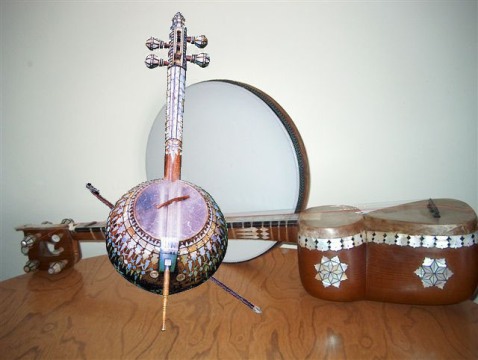Mugham: pearl of Azerbaijani music

By Nigar Orujova, AzerNews Staff Writer
The International Day of Azerbaijani Mugham and music day of the countries situated on the ancient Silk Road was celebrated on Aug. 26 in Azerbaijan.
The concert program "Mugham: from past till now" was held in Zira, outskirts Baku on this occasion in the performance of a Zira band and young musicians.
Azerbaijan's traditional folk music, Mugham, started to enter into the world culture in the beginning of the last century.
UNESCO included "Azerbaijani music" record consisting of 50 albums into the collection of "Anthology of the world's traditional music" in 1971. The records of Azerbaijan's mugham were reissued by UNESCO in series of "Musical sources" in 1975.
In 2003, UNESCO recognized mugam as a Masterpiece of Oral and Intangible Cultural Heritage of Humanity.
Azerbaijan encourages the art of mugham through holding international festivals and competitions. Furthermore, the International Center of Mugham was built in the form of tar (an Azerbaijani music instrument) in Baku in 2008.
Two international mugham festivals have been recently held in Baku with the participation of world musical bands. The main goal of these festivals was to popularize Azerbaijani mugham in the modern world.
Vocal-instrumental varieties of the compositions are performed by a group of the performers, consisting of a singer - khanende, playing on gaval (percussion musical instrument), tar (stringed musical instrument) and kamancha (stringed musical instrument).
The music of mugham attracts young and old people by its luscious and delightful sounds, which are pleasing ears.
From ancient till now
Geographically, the area of mugham music uprising can be considered from the territory of living and formation of Azerbaijani people. Thus, all Caucasus peoples assimilated mugham through Azerbaijan, which was the main distributor of this art in the region.
The art of mugham originated in the historical pre-Islamic period, exactly in the 1st to 4th centuries, when two states -- Atropatena and Albania - existed in the territory of Azerbaijan
The art of music in ancient Atropatena (South Azerbaijan) was connected with the Zoroastrianism religion. Followers of this religion were called Mag, who accompanied their religious ceremonies with music. The word mugham supposed to be originated from this sacred word, and mugham is close to this sacred music in melodic and rhythm peculiarities.
However, Albania [North Azerbaijan] practiced both Zoroastrianism and Christianity. The Azerbaijani mugham has many in common with the church music of Albania, in solo, chorus and polytonality.
The new stage of mugham was related to Islam religion in the 7th century. The Arabian art was not well developed at that period, but Arabs were respectful to the art of other countries when they were spreading Islam.
In that period the main usage of music was associated with singing Koran. When Islam religion spread in Azerbaijan, local religious figures performed Koran with the mugham peculiarities. This also influenced the Arabian way of religion singing, as in azan.
There is also a theory that Arabian "makam" as well as Azerbaijani mugham originated from the Sufis (mystical Islam dimension) "magma" notion. Sufis used music in their religious ceremonies. Azerbaijani Sufis used mugham in their religious ceremonies.
In the middle ages, the Azerbaijani literature strongly influenced mugham. The genre of ghazal (a poetic form) became the poetic base of the mugham and affected the art of mugham with rhythm features. Performance of the lyrical, philosophical and religious ghazals was accompanied with mugham music and produced a change in form and content of the mugham music language.
The art of mugham was developed and studied by scientists of the 13th and 14th centuries. The most prominent music scientist, Safiaddin Urmavi was the first scientist who singled out 12 mughams and six avazs in mugham and specified their mode structure.
The world greatest music scientist of the 14th - 15th centuries Abdulgadir Maraghai in his work devoted to the art of mugham analyzed and described every mugham section. Moreover, Maraghai informed about rhythmical forms and the rules of performance.
Later in 16th and 17th centuries mugham was considered to be a folk music and was mainly used in palaces. At this period, new styles and trends emerged in the art. Mugam performers sang ghazals of prominent Azerbaijani poets Nizami, Fizuli, Habibi and Shah Ismail Khatai.
Famous French scientist Alexander Duma during his visit to Caucasus attended one of those mugham competition in Shamakhy (north Azerbaijan) was greatly impressed by the music.
The mugham competitions were attended by singers from different regions of Azerbaijan, such as Karabakh (west of Azerbaijan) which is highly famous for its khanendes, Baki (capital of Azerbaijan), Tebriz (South Azerbaijan province of Iran) and others. The town of Shusha in Karabakh region of Azerbaijan was particularly renowned for this art.
The 20th century was a turning point for the traditional Azerbaijani art of mugham. The noble Azerbaijani composer Uzeyir Hajibeyov created 'Leyli and Majnun' mugham opera, based on a synthesis of mugham and European classical music, hereby making the art of mugham world-known.
The next step to develop mugham was made by the remarkable Azerbaijani composer, Gara Garayev, who created mugham symphony.
The mugham, which roots deep in the history, is regarded a pearl of Azerbaijani music art and frequently applied music among singers and musical bands all over the world, as well as mainstream audience.
Here we are to serve you with news right now. It does not cost much, but worth your attention.
Choose to support open, independent, quality journalism and subscribe on a monthly basis.
By subscribing to our online newspaper, you can have full digital access to all news, analysis, and much more.
You can also follow AzerNEWS on Twitter @AzerNewsAz or Facebook @AzerNewsNewspaper
Thank you!
